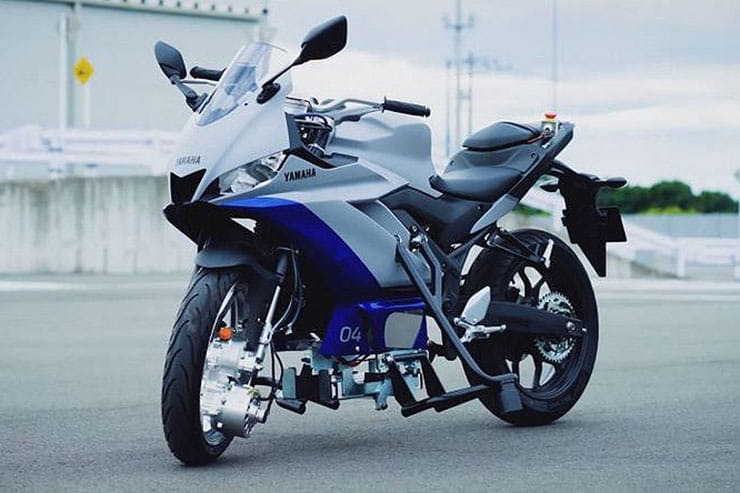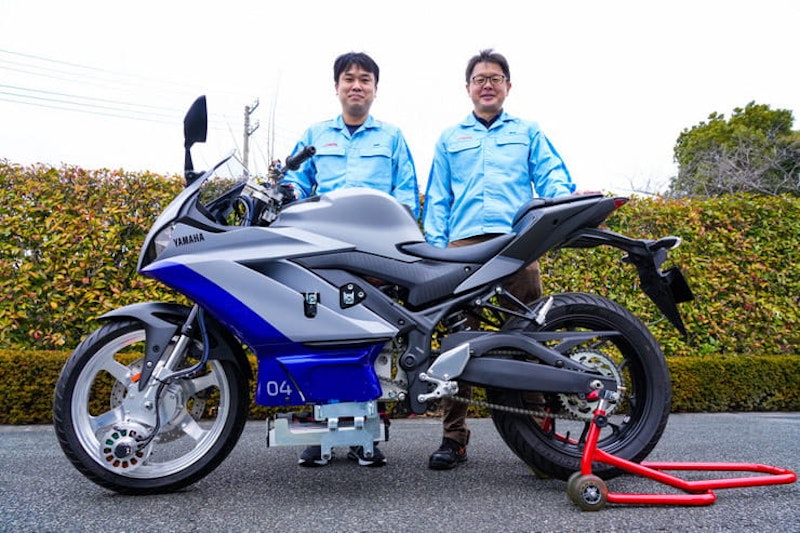Anti-crash Yamaha: Not an April Fool
By Ben Purvis
Motorcycle Journalist
28.03.2023
Mention you ride a motorcycle to a non-rider and as sure as night follows day you know that the question of risk will be wending its way into the conversation. We all make judgements of risk and reward on a daily basis and riding a bike is just another of those calls.
So what if the risk was removed? Both Honda and Yamaha have set the target of eliminating motorcycle fatalities by 2050 – a date that might seem a long way off, but in terms of bikes is only a couple of generations of machines away. That means the technology needed to achieve that goal needs to be under development now and introduced to production within the next few years. Yamaha’s AMSAS prototype, seen here, demonstrates key elements of that tech.
AMSAS stands for Advanced Motorcycle Stabilization Assist System and while the bones of this prototype come from a Yamaha R25 (essentially the same as the R3 we get in the UK) the key elements of its technology could be bolted to virtually any bike.
They’re made up of a steering assist system that can turn the bars automatically to help keep you upright, along with an electric drive mounted on the front wheel that provides stability at low speed. In fact, low speed is where the prototype stays, as it’s been stripped of the combustion engine that would normally drive the rear wheel and give it the ability to go more quickly.
Like Yamaha’s MotoBot, the AMSAS prototype is able to balance itself and be operated without a rider, but unlike that earlier development it can also carry a human. Eventually, the company hopes to be able to shrink the steering and front drive components, as well as the computer systems that operate them, to add to virtually any normal bike.
Yamaha says that a large proportion of bike accidents are down to rider error, with ‘recognition errors’ accounting for 10%, ‘decision errors’ for 17% and ‘operation errors’ another 5%. Eliminating those, by allowing the bike to take over when the rider makes the wrong call, is the aim. Yamaha has four paths – ‘assisted danger prediction’, ‘damage prevention and assisted defensive riding’, ‘assisted evasive riding manoeuvres’ and ‘damage mitigation’ – to achieve that goal.
Project leader Akitoshi Suzuki says the project’s most notable feature is “its approach to use an arrangement highly applicable to existing vehicles since it does not require any modifications to the frame.”
“With the base technologies in place now, we’re halfway to our goal of bringing AMSAS’ value to customers. From here on, we’ll be working to downscale the sizes of the various components and so on, as we want to develop it into a platform not just for motorcycles, but one also adaptable to a wide range of other personal mobility applications, like bicycles.”
Jun Sakamoto, in charge of safety strategy at Yamaha, says: “It’s to create conditions where the rider can focus more on operating their bike, so that everyone can enjoy that sense of being one with your machine. By providing an assist when the bike is more unstable and requires skill to operate, we want to deliver fun rooted in peace of mind to a wide range of riders.”
The main components of the AMSAS prototype’s safety systems are bunched around the front end. The steering system features a bar-mounted actuator to assist the rider. Yamaha is already using a system on some of its works motocross bikes, introduced a year ago, that doubles as an active steering damper and a power steering system, and creating an active steering system to help avoid accidents and maintain a bike’s balance is a natural step forward from that technology.
The front drive is more unusual, looking very much like a proof-of-concept prototype – with a bulky motor attached to gearing in the front hub. There’s clearly plenty of scope to scale-down the components, but Yamaha says this ‘drive actuator’ helps stability when starting and stopping and at walking pace – up to around 5km/h. They whole system takes its information from a 6-axis inertial measurement unit of the sort that’s already commonplace in traction control and cornering ABS setups.
Japanese video on Yamaha’s YouTube channel shows the bike in action last year, both with and without a rider aboard, demonstrating some enviable low-speed balance. As shown in the video, the front wheel motor even allows it to move forwards and backwards, just fractionally, to remain upright when stationary.
Allied to traction control and antilock systems that respectively allow computers to prevent the worst of a rider’s transgressions in overusing the throttle or the brake lever, a control that can subtly assist in steering is the final piece of a jigsaw of rider assistance. Throw in additional information from sensors like the radar that Yamaha introduced on the Tracer 9 this year, and the path towards the firm’s zero-fatalities goal – while still long – starts to look a lot clearer.
Share on social media:

